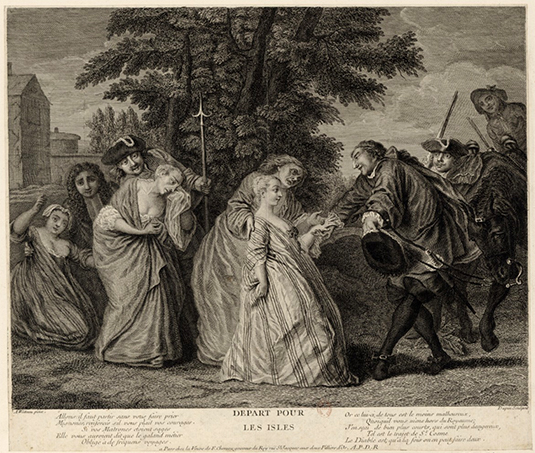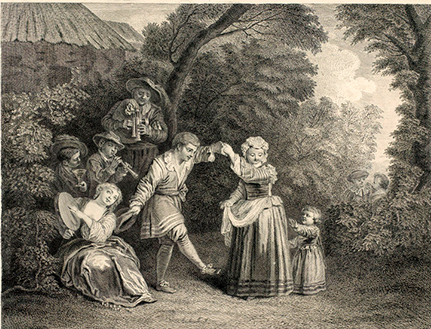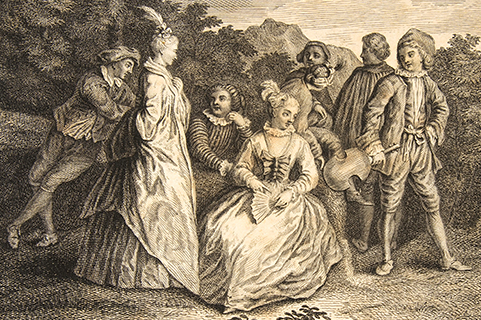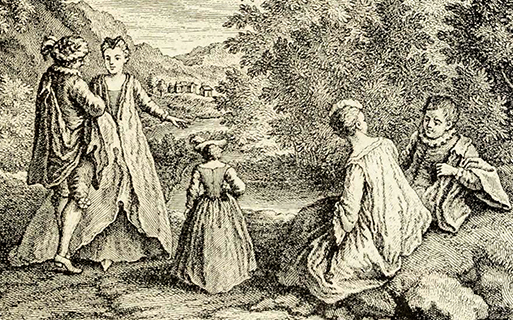
- Home Page
- Accepted
Paintings & Copies - Doubtful
Attributions - Doubtful Textual References
- Alternative
Titles - Collectors &
Museums - Bibliography
- Search Abecedario
- Watteau &
His Circle
Le Départ pour les isles
Entered May 2020

Presumed lost
Materials unknown
83.7 x 105.3 cm
ALTERNATIVE TITLES
Departure for the Islands
Desportazione di cortigiane
Un Embarquement des filles
Filles galantes partants pour les Iles
RELATED PRINTS

Pierre Dupin after Watteau, Départ pour les isles, engraving, c. 1730-40.
The painting was engraved by Pierre Dupin (c. 1690-1751) and the legend below declares at the left “A Watteau pinx” and at the right “P. Dupin Sculp.” The date of execution is unknown; the print was not advertised for sale in the Mercure de France.
PROVENANCE
Paris, collection of Jacques Gautier (or Gaultier) (d. 1759; Sécretaire du Roi). His sale, Paris, April 6, 1759, lot 81: “Un Embarquement de filles, id. de trente-un pouces de haut sur trente-neuf de large, par Wateau.”
SELECT BIBLIOGRAPHY
Hédouin, “Watteau” (1845), 108.
Hédouin, Mosaïque (1856), cat. 109.
Goncourt, L’Art au XVIIIème siècle (1860), 55.
Goncourt, Catalogue raisonné (1875), cat. 23.
Josz, Watteau (1903), 339.
Dacier, Vuaflart, and Hérold, Jean de Jullienne et les graveurs (1921-29), 1: 105, 106, 263 ; 2: 44-46, 52, 54, 55, 122; 3: cat. 275.
Réau, “Watteau” (1928), cat. 179.
Adhémar, Watteau (1950), cat. 5.
Mathey, Watteau, peintures réapparues (1959), 46.
Macchia and Montagni, L’opera completa di Watteau (1968), cat. 7.
Saint-Paulien, “Watteau inconnu et trahi” (1971), 297.
Sheriff, “Love Hurts” (2016), 49-51.
Gies and Wall, The Eighteenth Centuries (2018), n. p.
RELATED DRAWINGS
No Watteau drawings are associated with this composition.
REMARKS
A number of issues surround Dupin’s engraving of Départ pour les isles. It was not a part of the original Jullienne Oeuvre gravé but was executed independently and later was incorporated with other prints, some by Dupin, to form a supplement. Dacier, Vuaflart, and Hérold noted two instances where these supplementary prints appear at the end of the second volume, but there are some eighteenth-century examples of the bound engravings that place the Dupin print close to the middle. When Dupin’s print was issued is moot, especially since it was not announced for sale in the Mercure in the same manner that the prints from the Jullienne series were advertised.
Most troubling of all is the inferior quality of the image. Unlike most Watteau scholars who have passed over this work, Adhémar wrote that the engraving seemed distant from the spirit of Watteau. Likewise, Macchia and Montagni (who generally parroted Adhémar), found it difficult to believe that Watteau authored this composition. Indeed, Le Départ pour les isles is singularly awkward. The unconvincing gestures, the grimacing, even lecherous faces, the stumpy proportions of the young woman in the foreground, the awkward movements of the characters—all these elements cast doubt on Watteau’s authorship of this work.

Dupin after Watteau, La Danse champêtre, engraving.
Are these faults inherent in Le Départ pour les isles or are they attributable to the poor quality of Dupin’s engraving? Many of the same issues appear in his engraving after Watteau’s La Danse champêtre, which likewise has clumsy figures, awkward gestures, and ugly faces—elements that find little correlation with paintings in Watteau’s accepted oeuvre. If Watteau’s painting in this instance was not the best, Dupin’s engraving exaggerates its faults.

Pierre Dupin after Jean Nicolas de La Hire, La Jeunesse indifférente (detail), engraving. New York, Metropolitan Museum of Art.

Jean-Baptiste Haussard after Jean Nicolas de La Hire, Amusements champêtres (detail), engraving, Paris, Bibliothèque nationale, Département des estampes et de la photographie.
Similar faults are found in Dupin’s engravings after other artists, such as his La Jeunesse indifférente, engraved after a painting by Jean Nicolas de La Hire. The stiff, awkward pose of the woman standing in the foreground of the composition very much resembles that of the young girl in his engraving of Le Départ pour les isles. So too the facial expressions of the man at the left and the seated woman correspond to those we see in his engraving of Le Départ pour les isles. They reveal Dupin’s art, not that of La Hire or Watteau. He failed as a reproductive artist because he let too much of his own personality intrude. It is useful to compare Dupin’s engraving after La Hire with Haussard’s engraving after the same artist. Haussard’s engraving reveals an artist close to Watteau in spirit, whereas Dupin’s engraving is somewhat eccentric—eccentric in much the same way as his engraving after Le Départ pour les isles.
Significantly, most scholars have avoided trying to situate the original painting in Watteau’s chronology. Those who did try sought to place it among Watteau’s early works, when his distinctive, sophisticated style had not yet formed. Thus, despite her mistrust of the picture, Adhémar dated it to c. 1702, the first year that Watteau was in Paris; Mathey proposed 1704-05; and Roland Michel opted for 1705-08. Some, like Macchia and Montagni, who listed this composition but did accept its attribution, sensibly abstained from voicing an opinion about the date of execution. The format of the composition, with its large figures filling the space, suggests Watteau’s work in the middle of his career or later, but the disfigurement resulting from Dupin’s disfigurement of the figures makes it difficult to be more specific.
Those scholars who have written about this painting have been chiefly concerned with its subject matter. Edmond de Goncourt described it as “la presse des filles de joie,” a description repeated by Réau. It was not until Dacier, Vuaflart, and Hérold that it was proposed that this was a round-up of prostitutes who would be taken to “les îles de Mississippi.” They refer to such an event that took place in May 1720 and was paid for by the Compagnie des Indes; it is described in Saint-Simon’s Memoires. But Watteau was probably in London at that moment.
Saint Paulien rejected the painting as a work by Watteau, noting that Antoine Crozat (the brother of Pierre, Watteau's patron) was not financially interested in Louisiana until 1712-13; the French did not colonize there until 1716-17; and women were not sent there by force until 1716-17. Although Saint Paulien’s aim was to undermine the attribution, this did not stop others from continuing to associate Watteau’s painting with the colonization of Mississippi. Sheriff wrote that the picture depicted “an event commonly seen in Regency France when it was policy to deport undesirables to Louisiana.” Since she notes that these forced departures did not begin until 1716, and were so notorious that there were riots from 1717 to 1720—all of which implies that she believes the painting is later than has been customarily thought.
While Sheriff’s dating might be possible, her charged interpretation of the work needs to be scrutinized. She claims that the three principal women represent three classes: the short woman wears a robe volante (supposedly to hide her pregnancy); the second woman is a sorrowing Mary Magdalene accompanied by a guard whose pike is a phallic parody of the staffs held by pilgrims to Cythera); and the third woman is lower class, accompanied by a judicial representative, represents passive resistance. Other critics would view Watteau’s painting as a representation of Antoine François Prévost’s novel, Manon Lescaut, even though that famous, somewhat scandalous book was not published until 1731, a decade after Watteau’s death.
Click here for copies of Le Départ pour les isles